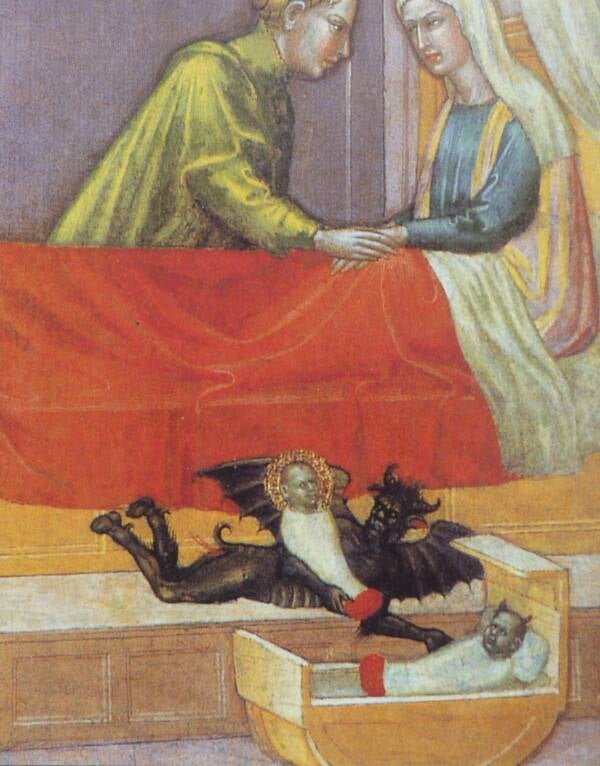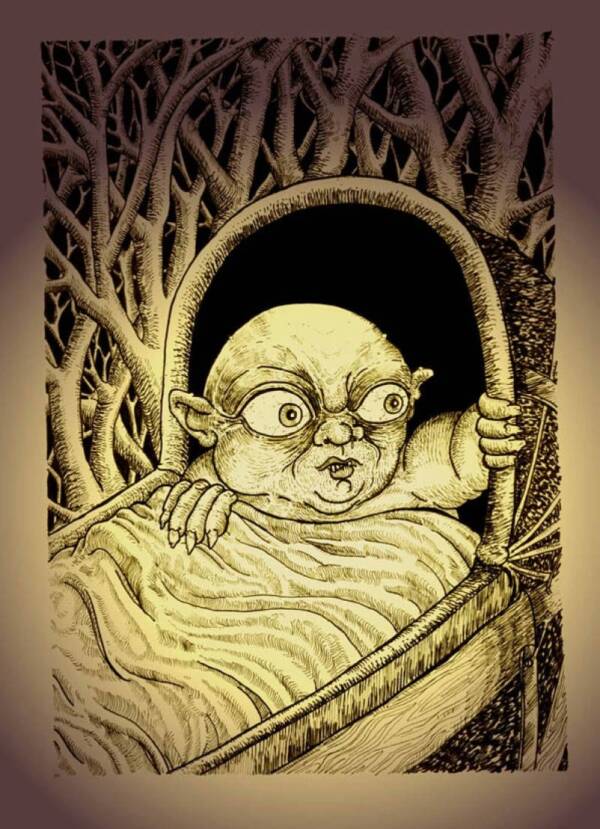For centuries, changelings were said to be fairy offspring left in place of kidnapped children. But the truth is that many kids believed to be these creatures simply had unknown illnesses.

Heritage Art/Heritage Images via Getty Images“The Changeling” by Henry Fuseli (1780).
European folklore is teeming with any number of strange and wondrous creatures, but perhaps none are more prevalent than the fairies.
Of course, the fairies of the past were quite different from their modern counterparts, more often feared as dangerous and powerful beings than revered as helpful companions. In many tales, fairies were not benign but wicked — and perhaps none represent this wickedness more than tales of changelings.
These creatures were imposters left in place of children whom the fairies had kidnapped, and though at first the changeling may appear to be one’s own child, there were several identifying traits that revealed changelings’ true identities. Some stories even say that the changeling must be tortured into revealing itself — which has led to many very real instances of child abuse.
Many modern folklorists and scholars believe the changeling myth may have grown from a lack of understanding of certain disabilities and conditions, like autism or physical illness. And this modern perspective only makes stories of changelings all the more disturbing.
The Changeling Legend As Told By The Brothers Grimm
In 1580, in a field near Breslau, Germany, there was a nobleman who, each summer, required his subjects to harvest his large crop of hay. None were exempt from this manual labor, not even a new mother who had given birth to her first child just one week earlier. Left with no choice, the young mother took her newborn with her to the nobleman’s field and set about her work, laying her child in a small patch of grass.
When she later returned to nurse the child, it began to howl in an inhuman fashion, and bit down so forcefully and greedily on her breast that the woman cried out in pain. This was nothing like the child she knew, but she returned home and kept the child for several days, all the while tolerating its foul behavior until she could bear it no longer.
She turned to the nobleman for help, and he told her, “Woman, if you think that this is not your child, then do this one thing. Take it out to the meadow where you left your previous child and beat it hard with a switch. Then you will witness a miracle.”
The woman did as he said, and beat the child with a switch until it screamed. It was then that the Devil appeared to her, holding her stolen child. The Devil said to her, “There, you have it!” And took his own child away.

Wikimedia CommonsA scene from “The legend of St. Stephen” by Martino di Bartolomeo, in which the devil steals a baby and leaves a changeling in its place.
This is but one version of a changeling tale as told by the Brothers Grimm and translated in an essay by D.L. Ashliman, and though this version incorporates the Devil in place of fairies, it is representative of the majority of changeling legends.
Versions Of The Changeling Myth Across Europe
Notably, the Brothers Grimm classified their changeling story as a legend, rather than a fairy tale.
In their own words, “The fairy tale is more poetic, the legend is more historical… While it is the children alone who believe in the reality of fairy tales, the folk have not yet stopped believing in their legends.”
The difference between a fairy tale and a legend, then, was that adults still believed in legends. In fact, it was precisely due to this belief that, as the Irish Post explained, in 1895, an Irish woman named Bridget Cleary was murdered by her husband — who believed she was a changeling.
Some versions of the legends claimed that changelings were old fairies who wanted to live out the rest of their days being cared for by humans. Other versions claimed the changelings were fairy children.
The reason for abducting the human child varies as well: to reinforce the fairy stock, for love of their beauty, or to pay the Devil. They often took the most beautiful children, and the changeling left in its place was usually in some way deformed or ill-tempered, and often depicted as having a ravenous appetite.
According to the myths, the best way to get rid of this devilish creature was to harm it in some way, perhaps by beating it or even putting it in an oven.
The unfortunate reality of this, however, was that there were no changelings, and the children in these stories had not been stolen and replaced. The truth is that in pre-industrial Europe, peasant families needed strong children who could work the fields, and it was far easier to justify infanticide if your “unfit” child was in fact a changeling.
Justifying Infanticide — The Tragic Truth About Changelings
In A Dictionary of Fairies: Hobgoblins, Brownies, Bogies, and Other Supernatural Creatures, Katharine Mary Briggs identified the underlying circumstances at the root of many changeling tales:
“When the changeling is supposed… to be a fairy child it is often tormented or exposed to induce the fairy parents to change it back again… This method has been responsible for a dreadful amount of child suffering, particularly in Ireland… Infantile paralysis or any other unfamiliar disease among the various blights and illnesses that came on suddenly would be accounted for by supposing that the child had been changed, and as a rule the parents would be advised to beat it, expose it on a fairy hill or throw it on to the fire. Only occasionally were they advised to treat the child kindly so that their own children might be kindly treated in return.”
Ashliman reached a similar conclusion in his essay, noting that peasant families across pre-industrial Europe depended on each member of the family being productive. Therefore, children who were physically disabled, ill, or in some other way in need of extra attention were tragically viewed as burdens.

Myths and Folklore WikiSome legends say that a changeling would reveal itself if it could be made to laugh, though the methods were often much more violent.
“The fact that the changeling’s ravenous appetite is so frequently mentioned indicates that the parents of these unfortunate children saw in their continuing existence a threat to the sustenance of the entire family,” Ashliman wrote. “Changeling tales support other historical evidence in suggesting that infanticide was not infrequently the solution selected.”
Only on rare occasions were parents held responsible for this abuse, too. One such case took place in 1690, in Gotland, Sweden. A couple was placed on trial after leaving their 10-year-old child on a manure pile overnight on Christmas Eve. The child had been sickly and wasn’t growing properly; the couple believed this child was a changeling.
They hoped that by leaving their child out in such away, the elves who had supposedly stolen their original child would switch them again. Instead, the child died of exposure.
The Changeling Myth And Children With Disabilities
In some stories, such as the Icelandic tale, “The Changeling Who Stretched,” which tells of a boy who rapidly grew to adult size, changelings were not fairy children at all but rather adult fairies who took the form of a child — which could lead parents who believed their child was a changeling to fear that child.
Ashliman argued that this fear likely led some parents to view their children with disabilities as monsters, a belief that only really began to dwindle as science advanced throughout the 18th and 19th centuries.
For instance, in one disturbing case, in 1826, an old Irish woman named Ann Roche was caring for her four-year-old grandson Michael Leahy, who was unable to walk or sleep, when she drowned him in a river, allegedly believing the child was “fairy-struck,” according to Thomas Crofton Croker’s Fairy Legends and Traditions of the South of Ireland.
At the trial for his murder, Roche said she had drowned the child “to put the fairy out of it,” believing it would cure him. Roche was found not guilty.
“The very word ‘changeling,’ its synonym ‘killcrop,’ and their equivalents in other languages now have become historical curiosities,” Ashliman wrote, adding that these terms were “survivals of beliefs and practices that helped our northern European forebears — for good or for bad — face the problems of life and death when confronted with mentally or physically defective children.”

FacebookIdentifying traits of changelings aligned with many signs of physical or mental disabilities.
Today, we thankfully no longer view children with disabilities as “monsters” or magical replacements for children who have been stolen from us. Like other folk legends, changelings represent the beliefs and values of a specific place and time.
Unlike some other legends, however, changelings are not a concept rooted firmly in ancient history — and the recency of some of these real-life incidents stands as a marker for how far humanity has come in the past few centuries.
For more European folklore like the Changeling, explore the Fairy Glen, the Scottish valley so magical, legend says fairies created it. Or, read about the legend of the banshee, the crying woman of Ireland who can foretell death.





